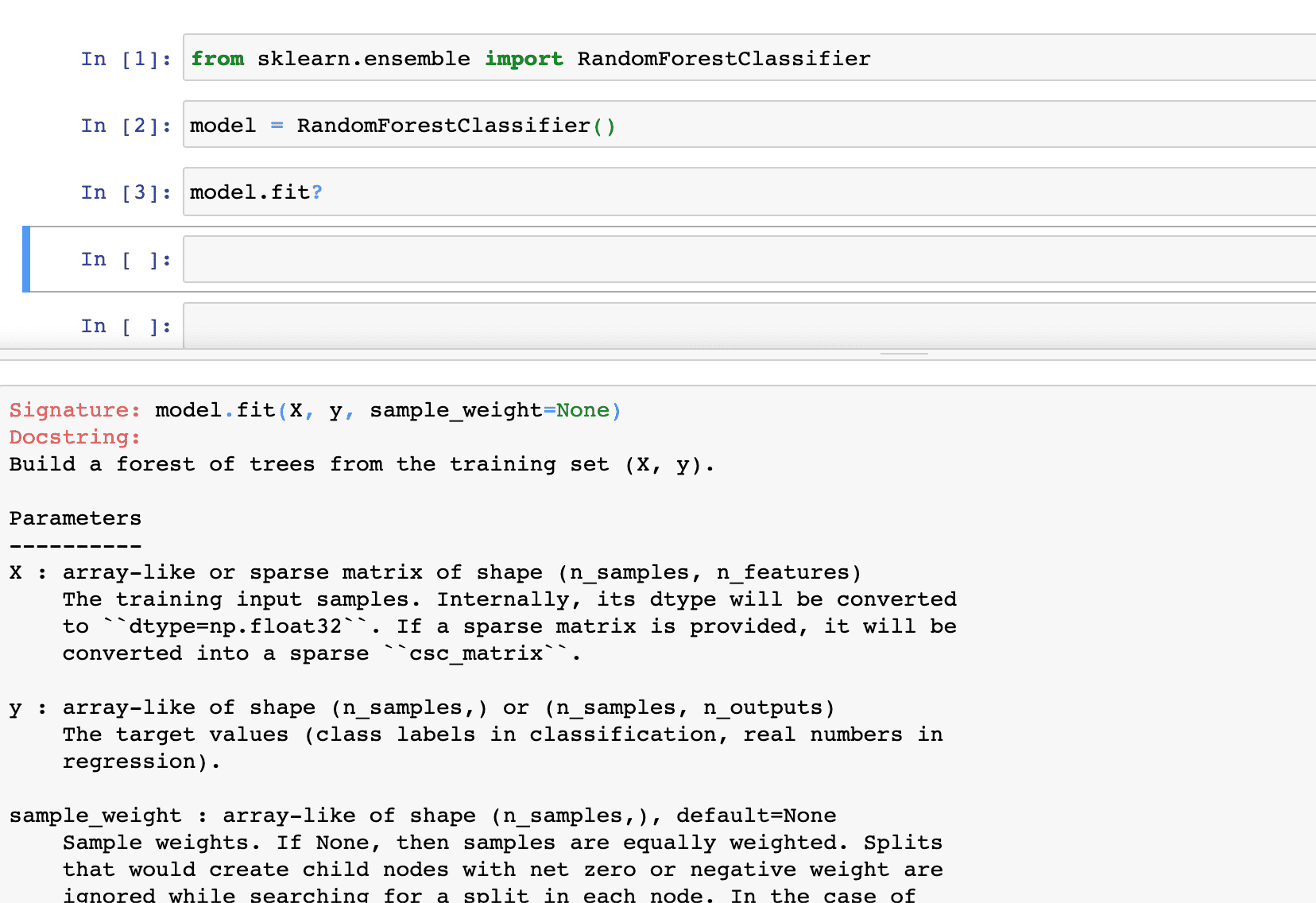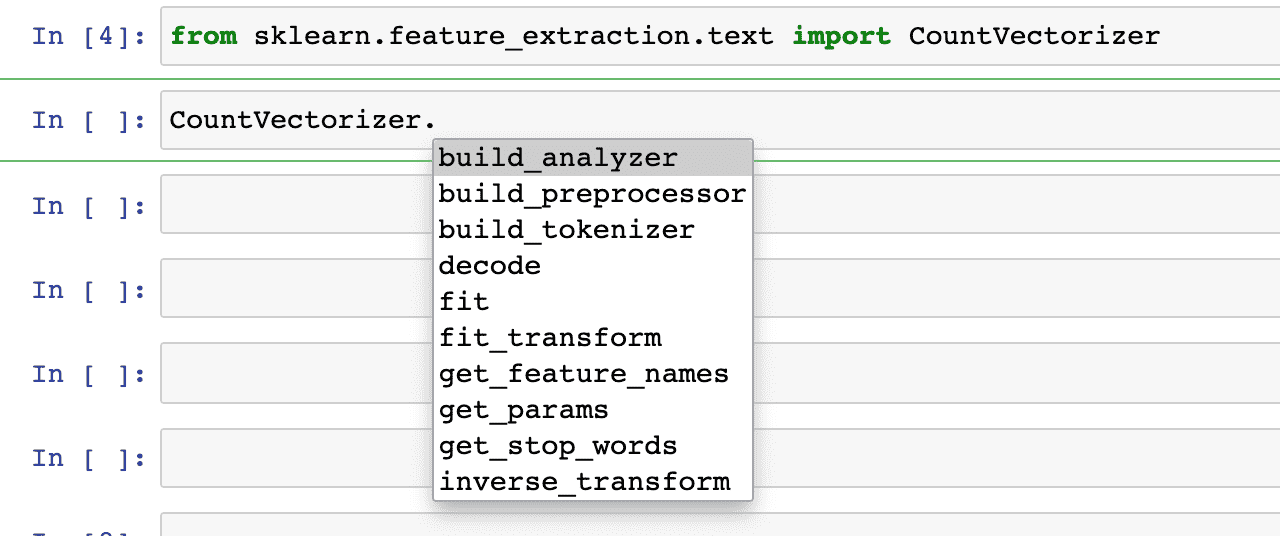-
질문 & 답변
카테고리
-
세부 분야
데이터 분석
-
해결 여부
미해결
pipeline transform과 fit_transform의 차이
20.11.02 00:51 작성 조회수 367
1
안녕하세요 강사님, NLP 또한 잘 보고 있는데 질문이 하나 있습니다.
아래에는 데이터를 벡터화 하기 위해 파이프라인의 fit_transform으로 변환했는데,
#벡터화 파라미터 설정하여 벡터화 템플릿 생성
vectorizer = CountVectorizer(analyzer ="word",
tokenizer=None,
preprocessor = None,
stop_words = None,
min_df = 2,
ngram_range=(1,3),
max_features = 20000
)
pipeline = Pipeline([
('vect', vectorizer),
])
%time train_data_features = pipeline.fit_transform(train["review_clean"])
train_data_features
뒤에서 실제 테스트 데이터를 벡터화할 때는 transform으로 하셨습니다.
%time test_data_features = pipeline.transform(clean_test_reviews)
test_data_features = test_data_features.toarray()
혹시 fit_transform()과 transform()의 차이가 있는지 문의드립니다.
NLP에 호기심이 많이 가는데, 복잡하고 어렵네요..
답변을 작성해보세요.
1

전재웅
질문자2020.11.02
상세한 설명 너무 감사합니다. 강사님
강의 퀄리티에 이어 질의응대도 감동이네요~
데이터 분석의 쪼랩들에게 매우 도움되는 내용인거 같아요. ?? 두개로 소스코드 보는 건 완전 꿀팁이네요.
아직 용어와 내용은 어렵지만 그래도 어떻게 접근하고 fit과 fit_transform에 대해 감 잡았습니다.
감사합니다 강사님~
1
박조은
지식공유자2020.11.02
안녕하세요.
좋은 질문을 주셨네요.
사이킷런은 fit, fit_transform, transform 과 같은 API를 갖고 있습니다.
이 API는 학습, 변환, 전처리 등에 사용됩니다.

fit은 위와 같이 주로 학습에 사용되며, fit_transform과 transform 은 숫자의 스케일변환, 텍스트 데이터 전처리, 데이터 인코딩, 결측치 대체 등에 사용됩니다.
이 API는 자연어 처리 뿐만 아니라 사이킷런에서 다양하게 사용되고 있습니다.
아래처럼 CountVectorizer를 부르고 관련된 메소드를 리스팅하면 fit, fit_transform, transform 이 모두 나옵니다.

그럼 어떨 때 fit, fit_transform, transform 을 사용해야 될지를 알아볼게요.
다음과 같이 ?를 통해 도움말을 호출했습니다.
내부에서 처리되는 건 비슷하지만 조금씩 다른 것을 확인해 보실 수 있습니다.
Signature: CountVectorizer.fit(self, raw_documents, y=None) Docstring: Learn a vocabulary dictionary of all tokens in the raw documents. Parameters ---------- raw_documents : iterable An iterable which yields either str, unicode or file objects. Returns ------- self
Signature: CountVectorizer.fit_transform(self, raw_documents, y=None) Docstring: Learn the vocabulary dictionary and return term-document matrix. This is equivalent to fit followed by transform, but more efficiently implemented. Parameters ---------- raw_documents : iterable An iterable which yields either str, unicode or file objects. Returns ------- X : array, [n_samples, n_features] Document-term matrix.
Signature: CountVectorizer.transform(self, raw_documents) Docstring: Transform documents to document-term matrix. Extract token counts out of raw text documents using the vocabulary fitted with fit or the one provided to the constructor. Parameters ---------- raw_documents : iterable An iterable which yields either str, unicode or file objects. Returns ------- X : sparse matrix, [n_samples, n_features] Document-term matrix.
또, fit의 소스코드를 보면 내부에서 fit_transform을 호출하는 것을 보실 수 있습니다.
Signature: CountVectorizer.fit(self, raw_documents, y=None) Source: def fit(self, raw_documents, y=None): """Learn a vocabulary dictionary of all tokens in the raw documents. Parameters ---------- raw_documents : iterable An iterable which yields either str, unicode or file objects. Returns ------- self """ self._warn_for_unused_params() self.fit_transform(raw_documents) return self
내부적으로는 모두 _count_vocab을 사용하게 되는데요.
vocabulary, X = self._count_vocab(raw_documents, self.fixed_vocabulary_)
transform은 변환작업을 하고 Document-term matrix를 반환합니다.
Source: def transform(self, raw_documents): """Transform documents to document-term matrix. Extract token counts out of raw text documents using the vocabulary fitted with fit or the one provided to the constructor. Parameters ---------- raw_documents : iterable An iterable which yields either str, unicode or file objects. Returns ------- X : sparse matrix, [n_samples, n_features] Document-term matrix. """ if isinstance(raw_documents, str): raise ValueError( "Iterable over raw text documents expected, " "string object received.") self._check_vocabulary() # use the same matrix-building strategy as fit_transform _, X = self._count_vocab(raw_documents, fixed_vocab=True) if self.binary: X.data.fill(1) return X
fit_transform 은 transform 과는 같은 기능을 하지만 transform 보다는 효율적이라고 합니다.
역시나 마찬가지로 Document-term matrix를 반환합니다.
보통 다른 기능에서 fit과 transform이 사용될 때는 fit, transform 을 각각 따로 해주고 fit_transform 에서는 fit과 transform을 한 번에 해주는데 여기에서는 TfidfVectorizer 와의 side effect 를 고려해서 transform을 부르지 않고 입력받은 파라메터 값에 따라 벡터화를 진행합니다.
Source: def fit_transform(self, raw_documents, y=None): """Learn the vocabulary dictionary and return term-document matrix. This is equivalent to fit followed by transform, but more efficiently implemented. Parameters ---------- raw_documents : iterable An iterable which yields either str, unicode or file objects. Returns ------- X : array, [n_samples, n_features] Document-term matrix. """ # We intentionally don't call the transform method to make # fit_transform overridable without unwanted side effects in # TfidfVectorizer. if isinstance(raw_documents, str): raise ValueError( "Iterable over raw text documents expected, " "string object received.") self._validate_params() self._validate_vocabulary() max_df = self.max_df min_df = self.min_df max_features = self.max_features vocabulary, X = self._count_vocab(raw_documents, self.fixed_vocabulary_) if self.binary: X.data.fill(1) if not self.fixed_vocabulary_: X = self._sort_features(X, vocabulary) n_doc = X.shape[0] max_doc_count = (max_df if isinstance(max_df, numbers.Integral) else max_df * n_doc) min_doc_count = (min_df if isinstance(min_df, numbers.Integral) else min_df * n_doc) if max_doc_count < min_doc_count: raise ValueError( "max_df corresponds to < documents than min_df") X, self.stop_words_ = self._limit_features(X, vocabulary, max_doc_count, min_doc_count, max_features) self.vocabulary_ = vocabulary return X
그리고 사이킷런에서는 fit은 주로 X, y가 있는 값 (지도학습) 혹은 y가 없는 값(비지도학습)에 사용되며
fit_transform, transform은 X만 있는 값(비지도학습)에 사용됩니다.
지도학습은 여기에서 처럼 영화리뷰의 감정분류가 True, False 형태로 Lable(정답값)이 있는 형태
비지도학습은 정답값이 없는 상태에서 군집화, 차원축소, 데이터 전처리 등 에서 주로 사용합니다.
위의 내부 소스코드는 각 API에서 물음표 두개 ?? 를 하시면 보실 수 있습니다!
물음표 하나 ? 는 도움말
물음표 두개 ?? 는 소스코드로 궁금하신 내용을 찾아보실 수 있습니다.
저 또한 내부 API를 익힐 때 이 방법을 주로 사용합니다 :)
0



답변 3